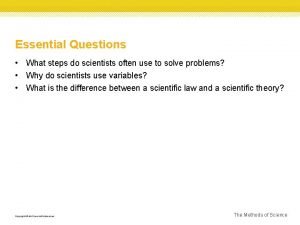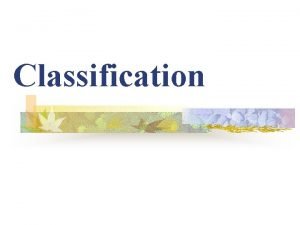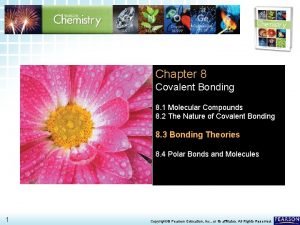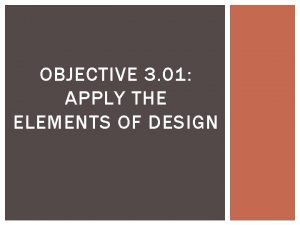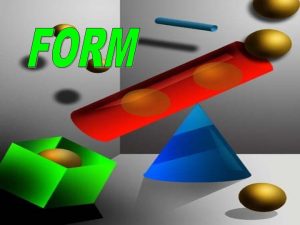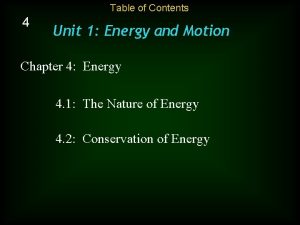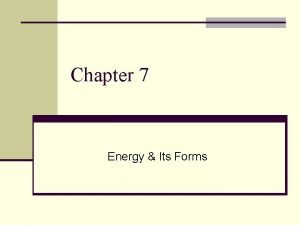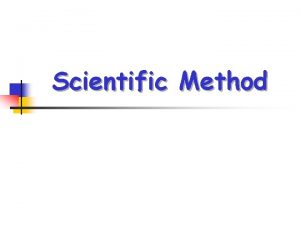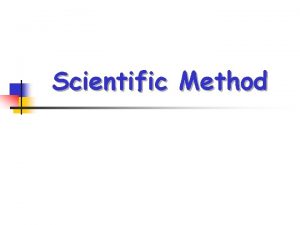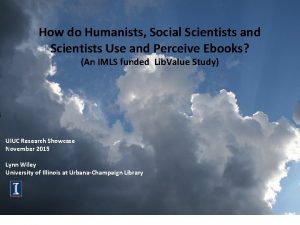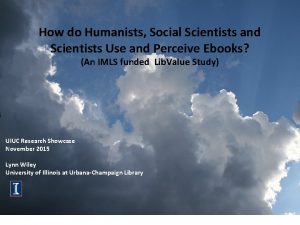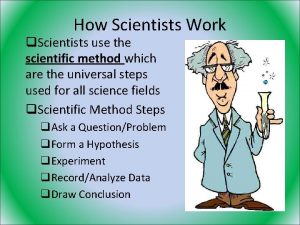Concept 1 3 Scientists use two main forms











- Slides: 11

Concept 1. 3: Scientists use two main forms of inquiry in their study of nature • The word Science is derived from Latin and means “to know” • Inquiry is the search for information and explanation • There are two main types of scientific inquiry: discovery science and hypothesis-based science Copyright © 2008 Pearson Education, Inc. , publishing as Pearson Benjamin Cummings

Discovery Science • Discovery science describes natural structures and processes • This approach is based on observation and the analysis of data • Data are recorded observations or items of information Copyright © 2008 Pearson Education, Inc. , publishing as Pearson Benjamin Cummings

Types of Data • Data fall into two categories: – Qualitative, or descriptions rather than measurements Copyright © 2008 Pearson Education, Inc. , publishing as Pearson Benjamin Cummings

Types of Data • Data fall into two categories: – Quantitative, or recorded measurements, which are sometimes organized into tables and graphs Copyright © 2008 Pearson Education, Inc. , publishing as Pearson Benjamin Cummings

Induction in Discovery Science • Inductive reasoning draws conclusions through the logical process of induction • Repeat specific observations can lead to important generalizations – For example, “the sun always rises in the east” Copyright © 2008 Pearson Education, Inc. , publishing as Pearson Benjamin Cummings

Hypothesis-Based Science • Observations can lead us to ask questions and propose hypothetical explanations called hypotheses Copyright © 2008 Pearson Education, Inc. , publishing as Pearson Benjamin Cummings

The Role of Hypotheses in Inquiry • A hypothesis is a tentative answer to a wellframed question • A scientific hypothesis leads to predictions that can be tested by observation or experimentation Copyright © 2008 Pearson Education, Inc. , publishing as Pearson Benjamin Cummings

Fig. 1 -24 • For example, – Observation: Your flashlight doesn’t work Observations – Question: Why doesn’t your flashlight work? – Hypothesis 1: The batteries are dead Question Hypothesis #1: Dead batteries Hypothesis #2: Burnt-out bulb Prediction: Replacing batteries will fix problem Prediction: Replacing bulb will fix problem – Hypothesis 2: The bulb is burnt out Test prediction • Both these hypotheses are testable Test falsifies hypothesis Test does not falsify hypothesis

A Closer Look at Hypotheses in Scientific Inquiry • A hypothesis must be testable and falsifiable • Hypothesis-based science often makes use of two or more alternative hypotheses Observations Question Hypothesis #1: Dead batteries Copyright © 2008 Pearson Education, Inc. , publishing as Pearson Benjamin Cummings Hypothesis #2: Burnt-out bulb

A Closer Look at Hypotheses in Scientific Inquiry • Failure to falsify a hypothesis does not prove that hypothesis – For example, you replace your flashlight bulb, and it now works; this supports the hypothesis that your bulb was burnt out, but does not prove it (perhaps the first bulb was inserted incorrectly) Copyright © 2008 Pearson Education, Inc. , publishing as Pearson Benjamin Cummings

Fig. 1 -24 b Hypothesis #1: Dead batteries Hypothesis #2: Burnt-out bulb Prediction: Replacing batteries will fix problem Prediction: Replacing bulb will fix problem Test prediction Test falsifies hypothesis Test does not falsify hypothesis
 What is significant figure
What is significant figure What steps do scientists often use to solve problems?
What steps do scientists often use to solve problems? Why do scientists classify things
Why do scientists classify things Bond 8 generacji
Bond 8 generacji Why are related forms more agreeable than unrelated forms
Why are related forms more agreeable than unrelated forms Negative long form
Negative long form Why are related forms more agreeable than unrelated forms
Why are related forms more agreeable than unrelated forms Why are related forms more agreeable than unrelated forms?
Why are related forms more agreeable than unrelated forms? Strong and weak forms of auxiliary verbs
Strong and weak forms of auxiliary verbs What are the main forms of energy
What are the main forms of energy Basic forms of energy
Basic forms of energy Chemical energy examples
Chemical energy examples

